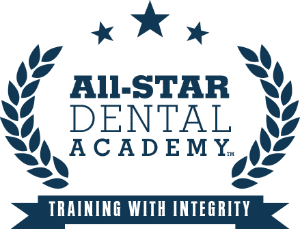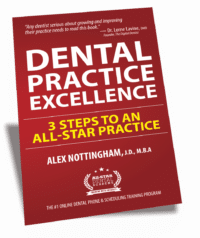Motivational Moments with Eric Vickery: Part Two of Ideal Day Scheduling, emphasizing the importance of case acceptance and financial arrangements for effective scheduling.
Resources:
About Eric Vickery
Eric holds a degree in business administration and brings a strong business and systems approach to his consulting. His initiation into the field of dentistry was in the area of office management. He managed dental practices for over ten years and has been consulting over 250 offices nationwide since 2001.
Episode Transcript
Transcript performed by A.I. Please excuse the typos.
00:02
This is Dental All-Stars, where we bring you the best in dentistry on marketing, management, and training. Hello friends, welcome to your weekly motivational moments with Eric Vickery, president of coaching at All-Star Dental Academy. This is part two of Ideal Day Scheduling, scheduling to success, scheduling advantage, blueprint scheduling, it’s been called a lot of things. This week is your second part of two parts, and we’re gonna talk about rules to follow. Last week we talked about
00:31
how to establish your goal and make sure everybody knows it. So you’re gonna measure it daily. We’ll get more to that at Morning Huddle. Today, this week, we’re gonna focus on the rules to follow. So how do you make sure that you’re doing what you ought to be doing to establish the goal? Well, first of all, you’re gonna need case acceptance to hit that goal. So we’re making a huge assumption. If a doctor comes to me and says, hey, we’re not hitting our goal every day, I look at the schedule and if there’s a lot of empty openings and oh.
01:00
open spots and people are scheduled really far out, we’re just not getting the case acceptance that you want. It’s going to be a challenge to hit that daily goal. So you need to establish some rules. And let’s work our way backwards. To get ideal day scheduling, you have to have had before that, ideal financial arrangements. In order to have ideal financial arrangements, before that, you’d have to have ideal case acceptance. In order to have ideal case acceptance, before that, you have to have ideal treatment planning, that whole process.
01:30
So all of that trickles down into the schedule. The schedule is a reflection of your systems in treatment planning, over here psychology, the things we’ve been working on with case acceptance, and then it’s also case presentation formula. Then it’s financial arrangements, which we’re going to do, just wait for that video. That is one of our systems. Now we’re to scheduling. So we’re really starting at the end of what we’re trying to accomplish here. So.
01:57
in your scheduling. All those things are happening. We’ve made that assumption that you guys are doing well with that, and now you have rules to follow. The first one to understand is that there’s a healthy ratio in your schedule. If you’ve got five hours of your time blocked for high productive, rock, primary appointments, that means you only have three hours available for the rest of the stuff. Or you can look at it this way.
02:24
80% of your day is designated to high productive things. Okay, five of your eight hours. So give or take. Now, the three hours, there’s gonna be a lot more appointments that will fit in that three hours. You know, new patients, emergencies, deliveries, single tooth, single surface composites, things like this, okay? You’re gonna have a lot more of that available to you, which means your three hour appointment block
02:54
time at the end of the day, that’s gonna be way far out. That’s gonna be booked out. So healthy ratio means, you know, sand, water, secondary, time is gonna be booked out further. And then on the primary, the rock time, the five hours that you establish, you don’t have as much of that typically. That’s not going to be booked out as far. That means your healthy ratio might be for every two weeks it takes to get in for a rock time, it might take four, six, eight weeks to get in
03:23
non-productive time or low productive time slot. So don’t worry about that. People are gonna have to wait for those afternoon, longer, shorter appointments that don’t have as much production. It’s not gonna take as long to get in for high production. That’s how it ought to be. Now, we’ll talk about when to break the rules in a moment. Understand this. If you have no high productive stuff going on because you don’t have those other things, case acceptance, you’re gonna get really nervous. You’re gonna…
03:52
Be like, we have openings tomorrow. That is not an ideal day scheduling problem, that’s a case acceptance problem. Keeping up with the rules, top down, bottom up scheduling. If you have a five hour block, your ideal schedule would be to put one patient in for five hours and hit your goal. Right, if it’s five hours and your goal is 500 per hour, it’d be a $2,500 appointment, whatever it was, okay? You do the multiplication, it works out where that five hour appointment hits your goal, then great, one patient.
04:19
All five hours, wonderful. They’re gonna do a lot of dentistry. Obviously the numbers would be much higher. But the problem I see is oftentimes we let the patient dictate where the appointment goes. Where would you like to come in? You can’t do that. The verbiage has to be right. Dr. Smith does this procedure. It’s a three hour appointment, either starting at 8 a.m. or starting at 10 a.m. to finish at 1 p.m. Which would work better for you. We’re here Monday through Thursday. Give them a choice, not a chance.
04:47
That way you set the parameters up where they can come in for this and they choose. If they say I need an afternoon, I absolutely can’t come in the morning, fine. Put that in the afternoon, but it’s gonna be a while to get in. Let them know that. Let them know the benefits to showing up in the morning for an appointment. That’s why we do them there. Their body reacts better to the procedure when it’s done in the morning. Top down, bottom up scheduling, meet in the middle. Never put an appointment right in the middle of the block. All right, when to break the rules. Every office is different.
05:16
But on breaking the rules, it might be the day before for you, it might be two business days before, it depends on your stomach lining. What can you handle? So make sure that you establish your rules for you when you break the rules on what you’re gonna put in to your high productive time. That is so important for everybody to know and then put really good notes in to say, hey, this was not scheduled here initially, but we had a cancellation or we had to fill something in and this was the warm body we got in and I know we’re not gonna hit gold today because of that.
05:46
I would also make sure that you establish new patient blocks, that you establish emergency blocks, that you put those in because that can really frustrate a scheduler and mess things up. I hope these rules help you. Focus on these for the whole week. I look forward to seeing you guys again next week. Thanks. We hope you enjoyed this episode of Dental All-Stars. Visit us online at allstardentalacademy.com








